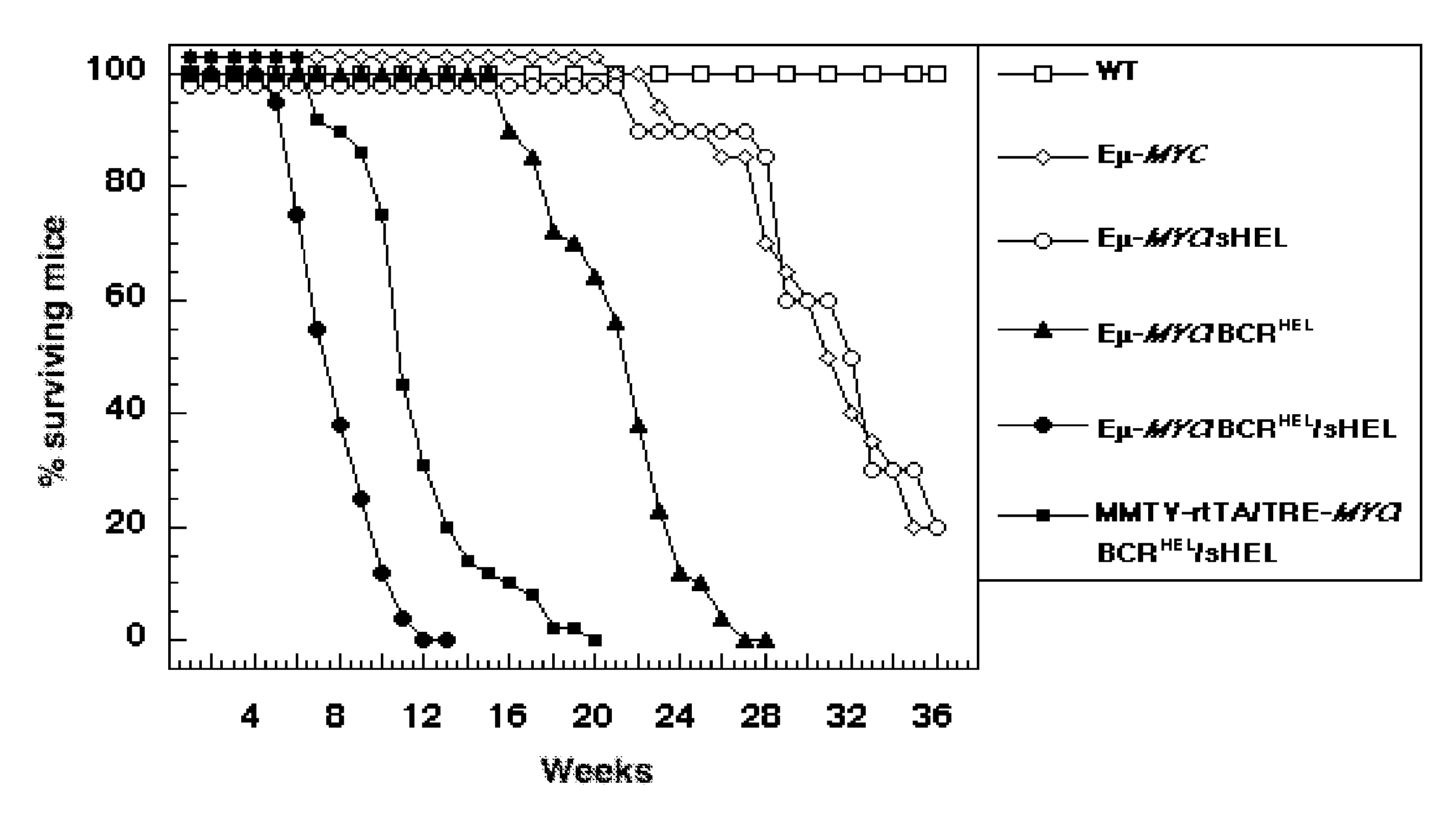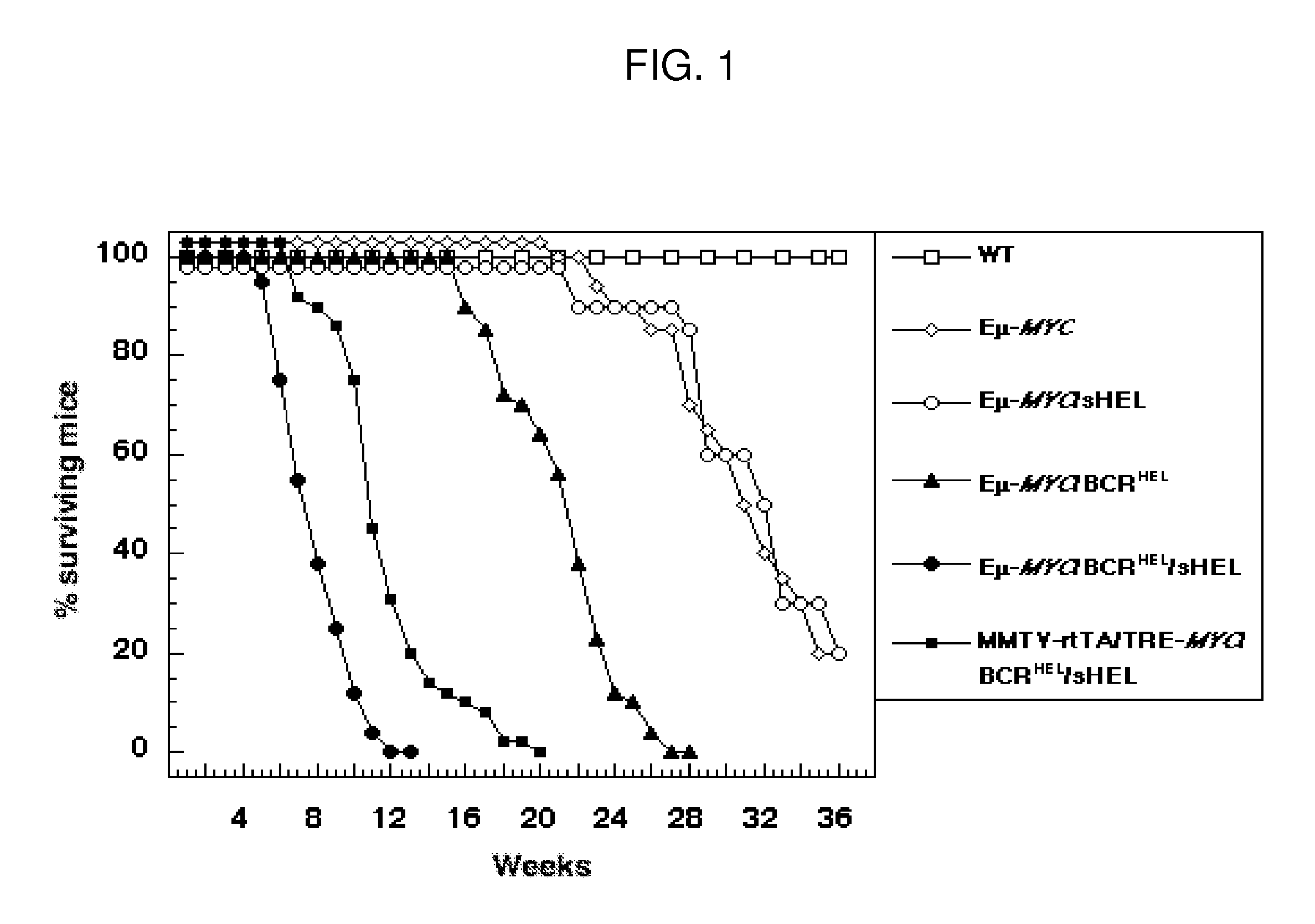Non-Human Animal Models for B-cell Non-Hodgkin's Lymphoma and Uses Thereof
a non-human animal model and lymphoma technology, applied in the field of non-human animal models for b-cell non-hodgkins lymphoma, can solve the problem that the tumor is still unclear and the tumor is not well understood
- Summary
- Abstract
- Description
- Claims
- Application Information
AI Technical Summary
Benefits of technology
Problems solved by technology
Method used
Image
Examples
example 1
[0258] The following example describes the production of a novel mouse model for the study of lymphomagenesis and for preclinical testing of therapeutics to treat chronic B-cell lymphocytic lymphomas (B-CLL) of humans.
Introduction of Antigenic Specificity into B-Cells Expressing a Transgene for MYC
[0259] In order to test the role of BCR signaling in lymphomagenesis, the inventors needed to generate mice containing B-cells that both overexpressed MYC and had a known antigenic specificity at a high frequency. To that end, a transgene for BCRHEL was bred into Eμ-MYC mice, creating a novel strain designated Eμ-MYC / BCRHEL, also referred to herein as a murine model for chronic B-cell lymphocytic lymphomas (B-CLL) of humans. Expression of the Eμ-MYC and BCRHEL transgenes was targeted to the B-cell lineage (Adams et al, 1985; Goodnow et al, 1988). Mice that express the Eμ-MYC transgene alone appear developmentally normal at first (Langdon et al, 1986), but later accumulate a large number...
example 2
[0268] The following example describes the production of a novel mouse model for the study of lymphomagenesis and for preclinical testing of therapeutics to treat human Burkitt's lymphoma (BL).
Antigenic Stimulation Altered Tumorigenesis by MYC
[0269] In order to explore how antigen stimulation of BCRHEL might affect tumorigenesis by MYC, the inventors bred a ubiquitously expressed transgene for sHEL into the Eμ-MYC / BCRHEL background. The resulting strain (Eμ-MYC / BCRHEL / sHEL) developed tumors even more rapidly than did Eμ-MYC / BCRHEL mice (FIG. 1).
[0270] Overgrowth of B-cells could be detected in the bone marrow, lymph nodes, spleen and thymus (FIGS. 2A-2D). B-cells also infiltrated the liver, lungs, and central nervous system. Compression and invasion of the spinal cord caused paralysis of the hind and fore limbs. Histological examination revealed a homogeneous population of large lymphocytes in the spleen, lymph nodes, thymus and bone marrow. The sheets of cells had a “starry sky...
example 3
[0287] The following example describes the production of a novel mouse model for the study of lymphomagenesis and for preclinical testing of therapeutics to treat human Follicular-like B-cell Lymphoma (FLL).
Antigenic Stimulation Altered Tumorigenesis by MYC
[0288] The inventors bred the BCRHEL and sHEL transgenes into a strain of mice that expresses MYC in the B-cell lineage (MMTV-rtTA / TRE-MYC). This strain allows for the temporal and tissue specific overexpression of MYC in an autoreactive B-cell background. The final composite strain was designated MMTV-rtTA / TRE-MYC / BCRHEL / sHEL. When the mice were maintained on a doxycycline-containing diet (200 mg / kg) (MYC transgenes remain silent) for four months, and then switched on to a diet containing a lower dose of doxycycline (50 mg / kg), the mice developed externally evident lymphadenopathy and splenomegaly accompanied by other clinical signs that are consistent with the onset of lymphoid neoplasia (scruffy fur, gasping, ascending hind ...
PUM
| Property | Measurement | Unit |
|---|---|---|
| pH | aaaaa | aaaaa |
| pH | aaaaa | aaaaa |
| volume | aaaaa | aaaaa |
Abstract
Description
Claims
Application Information
 Login to View More
Login to View More - R&D
- Intellectual Property
- Life Sciences
- Materials
- Tech Scout
- Unparalleled Data Quality
- Higher Quality Content
- 60% Fewer Hallucinations
Browse by: Latest US Patents, China's latest patents, Technical Efficacy Thesaurus, Application Domain, Technology Topic, Popular Technical Reports.
© 2025 PatSnap. All rights reserved.Legal|Privacy policy|Modern Slavery Act Transparency Statement|Sitemap|About US| Contact US: help@patsnap.com



